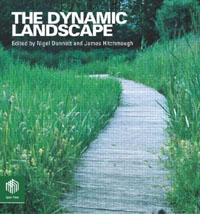
This is definitely an academic book, but you’ll find rare subject matter on current and past European research in planting design techniques available virtually no where else in the English language. Much this book has to offer is presented more attractively, and in much better prose, in Noel Kingsbury’s and Piet Oudolf’s Planting Design: Gardens in Time and Space, but the latter book has a much narrower focus on perennials and their horticultural use.
There are treasures here. One example is Hein Koningen’s stimulating article on maintenance of the naturalistic parks, called heemparks, that have been thriving in Amstelveen, a small city in The Netherlands, since the 1930s. The city, through highly knowledgeable park management and a locally trained staff of residents - many teenagers - has established a series of gardens, all planted appropriately to varying local ecologies, throughout the city. They are allowed to change over time, according to natural forces, unlike most “designed” gardens, where the plants are intended to stay put. But the heemparks are also managed, though infrequently and very carefully, by knowledgeable staff, who attempt to guide development, not make it fit a preconceived design.
Another is Anna Jorgensen’s chapter on the social and cultural context of ecological plantings, which reports on research into how different people respond to nature and to various types of park design, how different cultures and nationalities view nature, and how these views have changed over time. She quotes Daniel Defoe’s description of the Yorkshire Dales as “having a kind of an unhospitable Terror in them … all barren and wild, of no use or advantage either to man or beast,” and contrasts his view with “the fact that many millions of people now visit the Yorkshire Dales National Park for pleasure and recreation, attracted by the same landscape that Defoe found so repugnant.” Her piece is about where and how we draw the line between pretty and ugly, safe and threatening, designed and totally wild landscapes, and how that line moves over time and culture.
This book focuses on public gardens and plantings, and is the result of many years of research carried out at the University of Sheffield to develop low maintenance gardening and land management techniques for parks and other public places, with attention even to waste places, traffic islands, and roadsides. While much of the results of this research is applicable primarily in England and continental climates—because the local grasses and weeds are different from those in North America—and competition among plants can have different results in the differing locations—much of it is relevant to our growing conditions, climate, and native plant stock. Dunnett’s and Hitchmough’s research certainly provides stimulus to those of us willing to experiment with “naturalistic” planting.
For those of you who don’t live in a city, don’t be put off by the word “urban” in the subtitle. This book still offers much of interest. I garden in the woods in New Jersey, on a slope above a frequently raging creek a short distance before it plunges to the Delaware River. Dunnett’s and Hitchmough’s book contains a tremendous amount of information on naturalistic planting techniques and landscape management that I find of great use in my struggle with a wild landscape. I hope it will help me manage, not tame, my landscape. I recommend it as a book to read again and again, over several years.
The cost is daunting. I paid about $100 for my copy on Amazon.com.